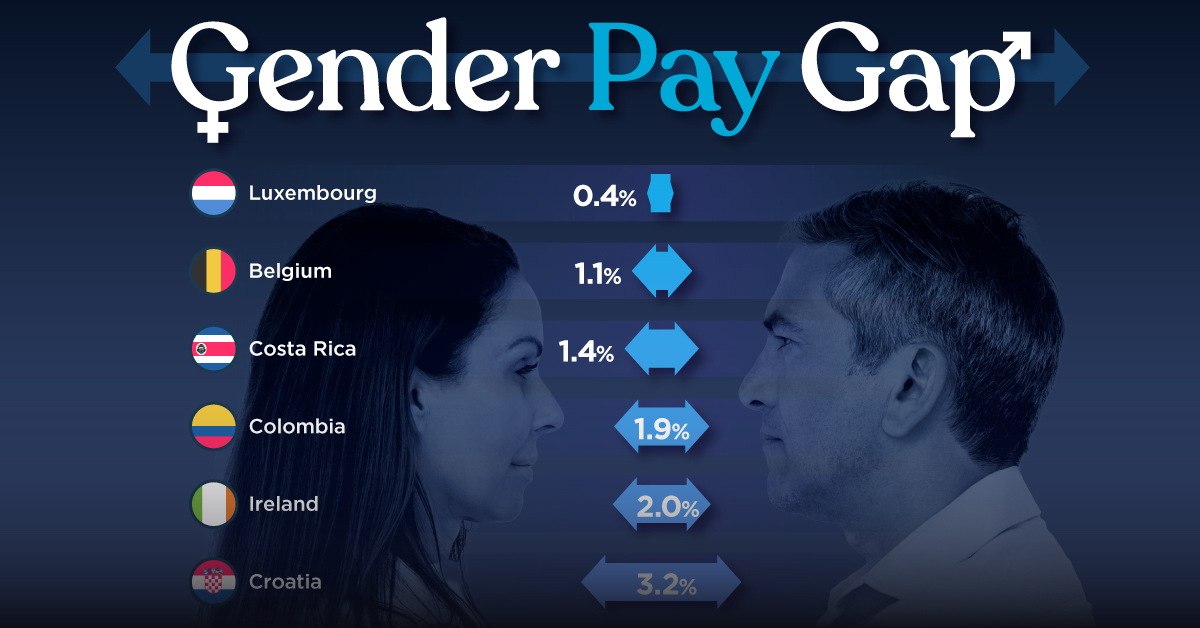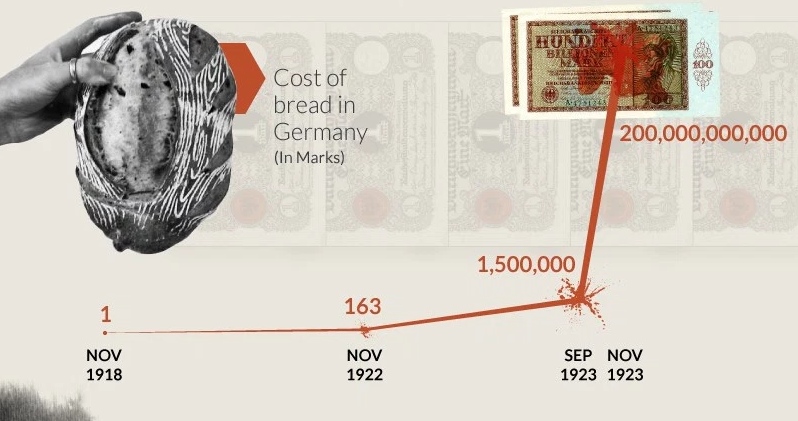Money
The World’s Most Famous Case of Hyperinflation (Pt. 2)

The World’s Most Famous Case of Hyperinflation (Part 2)
The Money Project is an ongoing collaboration between Visual Capitalist and Texas Precious Metals that seeks to use intuitive visualizations to explore the origins, nature, and use of money.
For the first infographic in this series, which summarizes the circumstances leading up to hyperinflation in Germany in 1921-1924, it can be found here: Hyperinflation (Part 1 of 2)
Slippery Slope
“Inflation took the basic law-and-order principles of loyalty and trust to the extreme.” Martin Geyer, Historian.
“As things stand, the only way to finance the cost of fighting the war is to shift the burden into the future through loans.” Karl Helfferich, an economist in 1915.
“There is a point at which printing money affects purchasing power by causing inflation.” Eduard Bernstein, socialist in 1918.
In the two years past World War I, the German government added to the monetary base of the Papiermark by printing money. Economic historian Carl-Ludwig Holtfrerich said that the “lubricant of inflation” helped breathe new life into the private sector.
The mark was trading for a low value against the dollar, sterling and the French franc and this helped to boost exports. Industrial output increased by 20% a year, unemployment fell to below 1 percent in 1922, and real wages rose significantly.
Then, suddenly this “lubricant” turned into a slippery slope: at its most severe, the monthly rate of inflation reached 3.25 billion percent, equivalent to prices doubling every 49 hours.
When did the “lubricant” of inflation turn into a toxic hyperinflationary spiral?
The ultimate trigger for German hyperinflation was the loss of trust in the government’s policy and debt. Foreign markets refused to buy German debt or Papiermarks, the exchange rate depreciated, and the rate of inflation accelerated.
The Effects
Hyperinflation in Germany left millions of hard-working savers with nothing left.
Over the course of months, what was enough money to start a stable retirement fund was no longer enough to buy even a loaf of bread.
Who was affected?
- The middle class – or Mittelstand – saw the value of their cash savings wiped out before their eyes.
- Wealth was transferred from general public to the government, which issued the money.
- Borrowers gained at the expense of lenders.
- Renters gained at the expense of property owners (In Germany’s case, rent ceilings did not keep pace with general price levels)
- The efficiency of the economy suffered, as people preferred to barter.
- People preferred to hold onto hard assets (commodities, gold, land) rather than paper money, which continually lost value.
Stories of Hyperinflation
During the peak of hyperinflation, workers were often paid twice a day. Workers would shop at midday to make sure their money didn’t lose more value. People burned paper bills in the stove, as they were cheaper than wood or other fuel.
Here some of the stories of ordinary Germans during the world’s most famous case of hyperinflation.
- “The price of tram rides and beef, theater tickets and school, newspapers and haircuts, sugar and bacon, is going up every week,” Eugeni Xammar, a journalist, wrote in February 1923. “As a result no one knows how long their money will last, and people are living in constant fear, thinking of nothing but eating and drinking, buying and selling.”
- A man who drank two cups of coffee at 5,000 marks each was presented with a bill for 14,000 marks. When he asked about the large bill, he was told he should have ordered the coffees at the same time because the price had gone up in between cups.
- A young couple took a few hundred million marks to the theater box office hoping to see a show, but discovered it wasn’t nearly enough. Tickets were now a billion marks each.
- Historian Golo Mann wrote: “The effect of the devaluation of the German currency was like that of a second revolution, the first being the war and its immediate aftermath,” he concluded. Mann said deep-seated faith was being destroyed and replaced by fear and cynicism. “What was there to trust, who could you rely on if such were even possible?” he asked.
Even Worse Cases of Hyperinflation
While the German hyperinflation from 1921-1924 is the most known – it was not the worst episode in history.
In mid-1946, prices in Hungary doubled every fifteen hours, giving an inflation rate of 41.9 quintillion percent. By July 1946, the 1931 gold pengõ was worth 130 trillion paper pengõs.
Peak Inflation Rates:
Germany (1923): 3.5 billion percent
Zimbabwe (2008): 79.6 billion percent
Hungary (1946): 41.9 quintillion percent
Hyperinflation has been surprisingly common in the 20th century, happening many dozens of times throughout the world. It continues to happen even today in countries such as Venezuela.
What would become of Germany after its bout of hyperinflation?
A young man named Adolf Hitler began to grow angry that innocent Germans were starving…
“We are opposed to swarms of Americans and other foreigners raising prices throughout Germany while millions of Germans are starving because of the increased prices. We are equally opposed to German profiteers and we are demanding that all be imprisoned.” – Adolf Hitler, 1923, Chicago Tribune
About the Money Project
The Money Project aims to use intuitive visualizations to explore ideas around the very concept of money itself. Founded in 2015 by Visual Capitalist and Texas Precious Metals, the Money Project will look at the evolving nature of money, and will try to answer the difficult questions that prevent us from truly understanding the role that money plays in finance, investments, and accumulating wealth.
Demographics
The Smallest Gender Wage Gaps in OECD Countries
Which OECD countries have the smallest gender wage gaps? We look at the 10 countries with gaps lower than the average.

The Smallest Gender Pay Gaps in OECD Countries
This was originally posted on our Voronoi app. Download the app for free on iOS or Android and discover incredible data-driven charts from a variety of trusted sources.
Among the 38 member countries in the Organization for Economic Cooperation and Development (OECD), several have made significant strides in addressing income inequality between men and women.
In this graphic we’ve ranked the OECD countries with the 10 smallest gender pay gaps, using the latest data from the OECD for 2022.
The gender pay gap is calculated as the difference between median full-time earnings for men and women divided by the median full-time earnings of men.
Which Countries Have the Smallest Gender Pay Gaps?
Luxembourg’s gender pay gap is the lowest among OECD members at only 0.4%—well below the OECD average of 11.6%.
| Rank | Country | Percentage Difference in Men's & Women's Full-time Earnings |
|---|---|---|
| 1 | 🇱🇺 Luxembourg | 0.4% |
| 2 | 🇧🇪 Belgium | 1.1% |
| 3 | 🇨🇷 Costa Rica | 1.4% |
| 4 | 🇨🇴 Colombia | 1.9% |
| 5 | 🇮🇪 Ireland | 2.0% |
| 6 | 🇭🇷 Croatia | 3.2% |
| 7 | 🇮🇹 Italy | 3.3% |
| 8 | 🇳🇴 Norway | 4.5% |
| 9 | 🇩🇰 Denmark | 5.8% |
| 10 | 🇵🇹 Portugal | 6.1% |
| OECD Average | 11.6% |
Notably, eight of the top 10 countries with the smallest gender pay gaps are located in Europe, as labor equality laws designed to target gender differences have begun to pay off.
The two other countries that made the list were Costa Rica (1.4%) and Colombia (1.9%), which came in third and fourth place, respectively.
How Did Luxembourg (Nearly) Eliminate its Gender Wage Gap?
Luxembourg’s virtually-non-existent gender wage gap in 2020 can be traced back to its diligent efforts to prioritize equal pay. Since 2016, firms that have not complied with the Labor Code’s equal pay laws have been subjected to penalizing fines ranging from €251 to €25,000.
Higher female education rates also contribute to the diminishing pay gap, with Luxembourg tied for first in the educational attainment rankings of the World Economic Forum’s Global Gender Gap Index Report for 2023.
See More Graphics about Demographics and Money
While these 10 countries are well below the OECD’s average gender pay gap of 11.6%, many OECD member countries including the U.S. are significantly above the average. To see the full list of the top 10 OECD countries with the largest gender pay gaps, check out this visualization.
-

 Mining2 weeks ago
Mining2 weeks agoCharted: The Value Gap Between the Gold Price and Gold Miners
-

 Real Estate1 week ago
Real Estate1 week agoRanked: The Most Valuable Housing Markets in America
-

 Business1 week ago
Business1 week agoCharted: Big Four Market Share by S&P 500 Audits
-

 AI1 week ago
AI1 week agoThe Stock Performance of U.S. Chipmakers So Far in 2024
-

 Misc1 week ago
Misc1 week agoAlmost Every EV Stock is Down After Q1 2024
-

 Money2 weeks ago
Money2 weeks agoWhere Does One U.S. Tax Dollar Go?
-

 Green2 weeks ago
Green2 weeks agoRanked: Top Countries by Total Forest Loss Since 2001
-

 Real Estate2 weeks ago
Real Estate2 weeks agoVisualizing America’s Shortage of Affordable Homes















